By Julie Power
Kathleen Butler’s official title was Confidential Secretary. Others called her the Bridge Girl.
Without her, the engineer of the Sydney Harbour Bridge John Bradfield said the “great scheme” to link the city’s north and south may have never been realised.
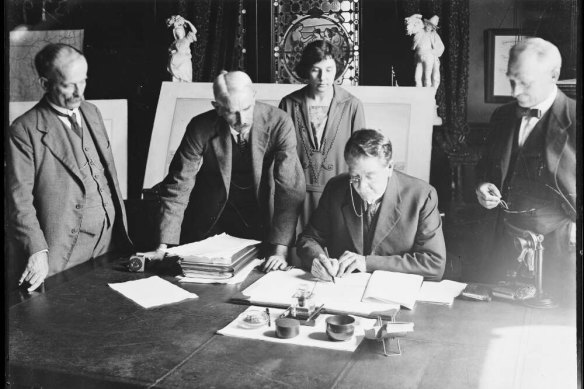
Kathleen Butler watches with John Bradfield (first left) as the minister signs the contract to build the Harbour Bridge, March 24, 1924. Credit: NSW State Archives
A newspaper in 1922 marvelled at Butler’s achievements and efficiency. Despite no formal training in engineering, the 31-year-old ‘Clever Girl’, as one newspaper described her, had set out the specifications for the bridge’s construction.
Butler is one of eight women whose contribution to NSW history will be recognised with a blue plaque, said Penny Sharpe, NSW minister for heritage, climate change and energy.
“Too much of our history ignores the stories of women,” she said, announcing the second round of blue plaques. They are displayed on a building or place relevant to each winner. “It’s wonderful to see the woman dubbed ‘the Godmother of the Sydney Harbour Bridge’ recognised for her significant role in the bridge’s conception and development.”
Other notable women recognised this year include the cofounder of the Country Women’s Association, Grace Munro; author Charmian Clift; and two Indigenous activists, Emma Jane Callaghan and Pearl Mary Gibbs.
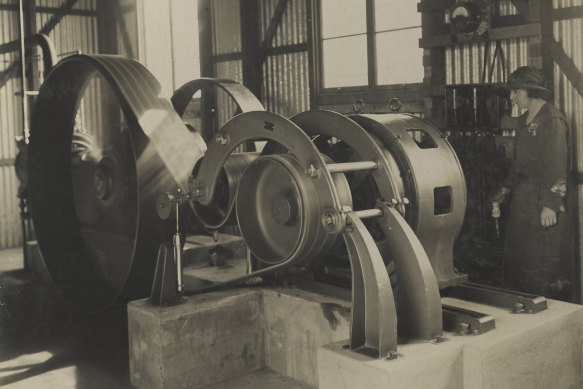
Kathleen Butler, aka the Bridge Girl, turning on the switch for the first construction of the Harbour Bridge 100 years ago. Credit: NSW Museums of History
Another six people and events will also be recognised with a plaque, including the surf club at Bondi, the artist William Dobell, and the spot at Balldale where myxomatosis was released to end the rabbit plague.
Sharpe said Butler’s job title as Confidential Secretary to Chief Engineer John JC Bradfield “belied her multiple roles as project manager, tender manager, negotiator, administrator and publicist”.
Though most people recognise the achievements of Bradfield, not many people today know about Butler, said Bill Phippen, a heritage expert with Engineers Australia.
When Butler travelled to the United Kingdom on bridge business for Bradfield, she was hailed as a symbol of women’s rights, he said.
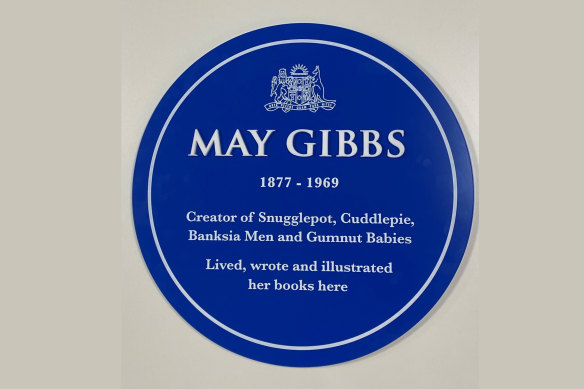
An example of the blue plaques. Children’s author May Gibbs was one of the first people to receive one.
She was a sensation, he said. The Vote - The Organ of the Women’s Freedom League called her an “Australian Woman Pioneer”.
“Plainly, in the women’s suffrage environment of the United Kingdom in 1924, a young woman building the greatest bridge in the world was remarkable,” said Phippen who wrote a submission lobbying for her recognition.
It was exciting for Butler, too, who often remarked that she was the only woman at history-making events with ministers and dignitaries.
Bradfield likely met Butler for the first time when she was 19 when she started in the public works department. She became his first employee on the Bridge project two years later.
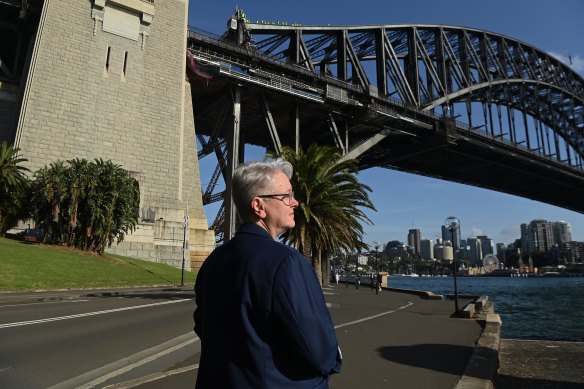
Penny Sharpe at the base of the Sydney Harbour Bridge which is linked to one of the historical Blue Plaques for Kathleen Butler.Credit: Kate Geraghty
He encouraged Butler, and recognised her work and talent with sizable bonuses that made her one of the best-paid women in NSW. He praised her publicly. “Preparing the Specification for the Sydney Harbour Bridge [Butler] was my only assistant; the technique of the Specification is hers, and it would, I think be impossible to find a better arranged or better-printed Specification.”
After decades of delays to the construction of the bridge, Butler also deftly circumvented a plan by a newly elected premier, Sir George Fuller, to again put the project on hold.
The premier told the press that a cable was to be sent to Bradfield in New York to ask him to stop and await instructions.
Butler circumvented the Premier’s plan, writes Phippen, by sending Bradfield a telegram “advising him to take the first possible ship out of the United States, to not be there to receive the official telegram”.
It was Butler, too, who was given the honour of performing the first act of construction in 1923, throwing the switch of an air compressor to power the first round of drilling.
On her return from the United Kingdom, she was invited to lunch in her honour by the Professional Women Workers Association (PWWA).
“The unique position which Miss Kathleen Butler holds in Sydney today is because Dr Bradfield dares to place a woman in a position of trust where merit, capacity and initiative counts,” said the resident of PWWA, Grace Scobie.
When she married, she was forced under public service rules of the time to resign from her job.
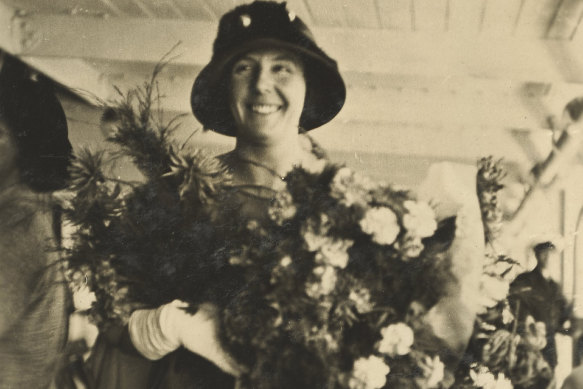
Kathleen Butler aboard SS Ormonde on April 30, 1924.Credit: NSW State Archives
She was still bridge crazy, telling a journalist that she hated to be out of it. Later in life, she bought a house in Sydney with views of the bridge.
The new plaques have been chosen from 117 nominations made by the public, assessed by independent historians. They join plaques, announced last year, that are already in place from Broken Hill to Bathurst.
Start the day with a summary of the day’s most important and interesting stories, analysis and insights. Sign up for our Morning Edition newsletter.
Second round of Blue Plaque winners
- Kathleen Butler: A woman without formal engineering qualifications with a central role in the development of the Sydney Harbour Bridge. Sydney
- Emma Jane Callaghan: Aboriginal midwife, activist, nurse, and Indigenous Culture Recorder. Philip Bay, Sydney
- Susan Katherina Schardt: Born blind, Schardt established the Commonwealth Home for Destitute Invalids,now known as Royal Rehab. Ryde
- Dorothy Simpson McGregor Drain: One of the first Australian female war correspondents, she was also a poet, and editor of The Australian Women’s Weekly. Glebe
- Establishment of the first recorded surf life savers club. Founded in 1907, the Bondi Surf Life Saving Club was the first in Australia. Bondi
- Sir William Dobell: Artist, three-time winner of the Archibald Prize. Wangi Wangi
- Syms Covington: Cabin boy on the HMS Beagle, assistant to Charles Darwin. Pambula
- Charmian Clift; A prolific writer and essayist. Kiama
- Pearl Mary Gibbs: A prominent female activist in the Aboriginal rights movement, Gibbs was heavily involved in the the Day of Mourning and Aboriginal Tent Embassy. Sydney CBD
- Ioannis (Jack) and Antonios (Tony) Notaras: Greek immigrant businessmen known forestablishing Grafton’s still-thriving Saraton Theatre. Grafton
- Beryl Mary McLaughlin, one of the first three women to graduate in architecture from the University of Sydney, Wentworth Falls
- Ken Thomas: Trucker and entrepreneur who established TNT transport empire and contributed to road safety. Murrumburrah
- Grace Emily Munro: Co-founder and first president of the Country Women’s Association. Bingara
- First release of myxomatosis in Balldalein 1950, to combat a severe rabbit problem.